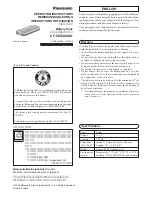
Operating Instructions
5
01806E
7.
When the temperature falls below 65°F, the
batteries should be placed on charge as soon
after use as possible. Cold batteries require
more time to fully recharge.
8.
The tops of the batteries and battery hold-downs
must be kept clean and dry at all times to
prevent excessive self-discharge and flow of
current between the battery posts and frame.
Electrolyte spilled on the batteries never dries or
evaporates and must be cleaned off.
9.
All connections to batteries that are bolted must
be maintained clean and bright. Due to heating
and discharge rates, bolted connections loosen
over time. Re-tighten the connections twice
yearly to the manufacturer's specified torque.
10. Follow all operating instructions, cautions, and
warnings as specified in this manual, on the
charger, and in your equipment owner manual.
TROUBLESHOOTING GUIDE
To be able to troubleshoot safely and effectively,
it is important to read this guide completely
before beginning any tests.
CAUTION: DO NOT DISASSEMBLE THE
CHARGER. TAKE IT TO A QUALIFIED SERVICE
AGENT WHEN SERVICE OR REPAIR IS
REQUIRED. INCORRECT REASSEMBLY MAY
RESULT IN A RISK OF ELECTRIC SHOCK OR
FIRE.
The following procedures are intended only to
determine if a malfunction may exist in the
charger.
DANGER: TO REDUCE THE RISK OF
ELECTRIC SHOCK, ALWAYS DISCONNECT
BOTH THE POWER SUPPLY CORD AND THE
OUTPUT CORD BEFORE ATTEMPTING ANY
MAINTENANCE OR CLEANING. TURNING THE
CHARGER OFF DOES NOT REDUCE THE RISK.
WARNING: DO NOT OPERATE THE
CHARGER IF IT IS MALFUNCTIONING.
PERSONAL INJURY OR PROPERTY DAMAGE
COULD RESULT.
To determine if a charger malfunction exists, identify
the problem from the following list and refer to the
appropriate section for detailed instructions.
1.
CHARGER DOES NOT TURN ON
2.
CHARGER FUSE BLOWS
3.
THE AMMETER NEEDLE REMAINS AT MORE
THAN 25 AMPS FOR MORE THAN 30
MINUTES
4.
CHARGER DOES NOT TURN OFF
5.
THE BUILDING AC LINE CIRCUIT BREAKER
OR FUSE BLOWS
If the problem is other than listed above, refer to a
qualified service agent for additional troubleshooting
procedures.
1.
Charger does not turn on
The DC plug must be disconnected and reconnected
to start the charger after turn off.
Test for a live outlet by connecting a light or
appliance to the same outlet.
2.
Charger fuse(s) blow
The charger fuse assembly consists of a "U" shaped
wire visible through a transparent cover, and is
mounted on the front panel. Electrical connections
to the fuse wire are soldered to the middle and each
end. Each half of the fuse wire serves as an
individual fuse link, which protects the charger in the
event one, or both rectifier diodes fail, or a reverse
polarity connection is made to the batteries.
Check the fuse assembly visually for an open or
blown fuse link. If both half links of the fuse
assembly blow as soon as the DC output plug is
connected to the battery connector, the polarity of
the batteries may be reversed. If no battery or
connector maintenance has been performed prior to
the fuse blowing, the charger is malfunctioning. If
only one half-link blows the charge rate will be low
and the charger is malfunctioning.
CAUTION: DO NOT USE THE CHARGER IF
THE OUTPUT IS LOW. BATTERIES WILL NOT
REACH FULL CHARGE, THEREBY INCREASING
THE POSSIBILITY OF A HARMFUL DEEP
DISCHARGE DURING THEIR NEXT USE.
3.
Ammeter needle remains at more than 25
amps for more than 30 minutes
This high charge rate is caused by misuse. The
charger is connected to a battery pack with a system
voltage lower than or amp-hour capacity greater
than specified on the charger. If connected to a
battery system of less than 48 volts, the charge rate
will not taper and decrease to 25 amps or less within
30 minutes. This is caused when one or more of the
batteries in the system are connected reverse
polarity.
4.
The charger does not turn off
New batteries or batteries charged in cold
temperatures may require an extended charge time
to achieve full charge. However, if the charger runs
for longer than the maximum listed without shutting
off, the charger is malfunctioning. Turn the charger
off by disconnecting the input plug before
disconnecting the charging plug.
5.
The building AC line circuit breaker or fuse
blows

























